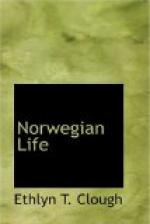If you will take your map and examine the north coast of Europe within the arctic circle, you will find several towns east of the North Cape on the White Sea which are wide open 365 days in the year, and do more business in the winter than during the summer months. They do not see the sun from December to February. At some places it is invisible for a longer period, but at Hammerfest the streets, houses, and business places are lighted with electric lights, and similar plants are being introduced into other cities of the polar section. It is stated, also, that the aurora borealis is so brilliant night after night as to make it easy to read ordinary newspaper print without artificial light, and by long experience people are prepared for the peculiar conditions that exist there. The passengers on the steamers in these waters in winter are mostly commercial travelers and men interested in the fisheries, which are more active from October to March than at any other time of the year.
There are also two canals in Norway that are used for passenger traffic—the Fredrikshald canal, connecting the Femsjoeen and Skullerud lakes, and the Skien-Nordsjoe-Bandak canal, connecting the Nordsjoe lake with the Hitterdal and Bandak lakes. Between the Hitterdal and the Nordsjoe lake there is a rise of fifty feet, which is overcome by two locks at Skien and four at Loveid; and between the Nordsjoe and the Bandak lakes there is a rise of one hundred and eighty-seven feet, which is overcome by fourteen locks, five of which are around a waterfall, the Vrangfos, where the average rise for each lock is about thirteen feet. The postal, telegraph, and telephone systems, all under government control, are both cheaper and more efficient than in the United States, where the two latter are private monopolies. With the exception of Switzerland, Norway is more abundantly supplied with postoffices, in proportion to her size, than any other country in the international postal union. The length of her telegraph lines, in relation to the population of the country is greater than in any other country. There is no place in the world where telephones are so cheap or so numerous as in Stockholm. There are more telephones in Stockholm than in Berlin or London, and it is contended that there are more than in Paris, but that is doubtful. The total number of instruments in use is nearly 50,000 to a population of 300,000. You can find a telephone in every shop and in almost every house, and in the parks and on the street corners on lamp posts are little booths similar to those used for police boxes in the cities of the United States. They work automatically. You drop a little coin worth three cents into the slot, and then ring the bell. For several years every room in the principal hotels has had its own telephone, on the same system that has recently been introduced into the United States, and upon some of the steamers sailing from Stockholm there is a telephone in every stateroom. The long distance ’phones and all the lines outside of two or three of the principal cities belong to the government and are operated by the Postoffice Department. The rents vary from $10 to $28 a year.




